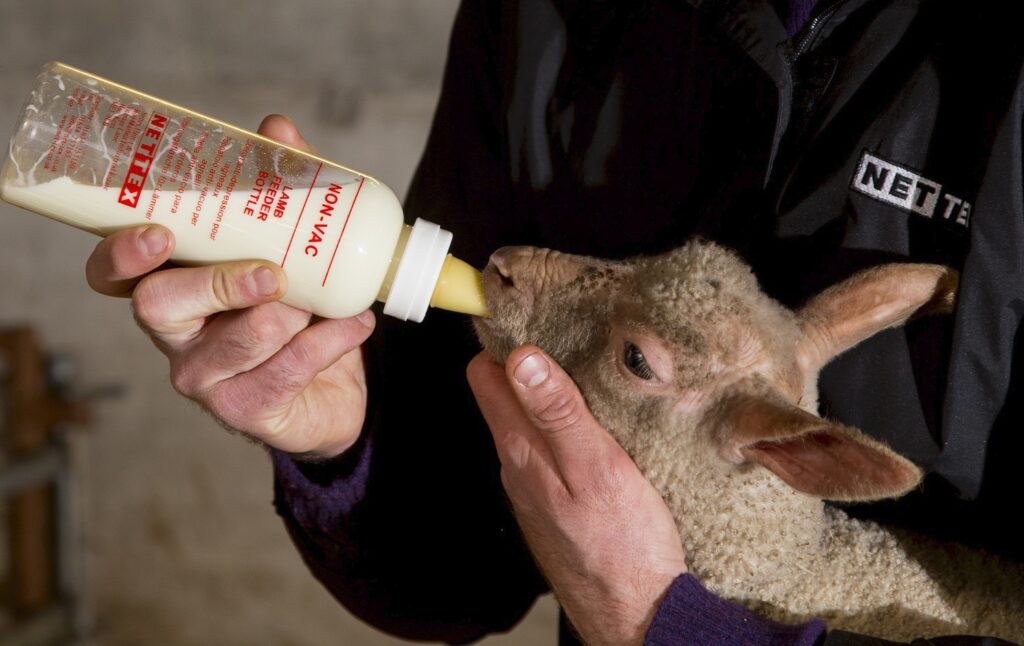How to use colostrum supplements at lambing
23rd December 2022
Lambs require adequate amounts of high quality colostrum for short and long-term health. Here’s how to supplement when quality and quantity fall short to keep lambs healthy.
Forty-nine per cent of lamb deaths occur within the first 48 hours of life. According to Emily Hall, a sheep farmer and product manager for Nettex, this is largely due to inadequate amounts of maternal colostrum being fed and lambs suffering from hypothermia and disease as a result – something that can be largely prevented with correct colostrum management.
“The thick, creamy consistency of colostrum is from its high fat content. This provides lambs with a rich energy source which allows them to maintain their body temperature and bodily functions,” she says.
At a minimum, lambs require 50ml/kg of bodyweight as a first feed. Within 24 hours they should receive 200ml/kg body weight.
“This means your average 5kg lamb will require 1000ml of colostrum – that is a high volume to consume in a short period of time,” says Ms Hall.
For lambs at risk of hypothermia, the rate of colostrum needs to be increased significantly.
Depending on a range of management and genetic factors, some ewes will struggle to produce high enough volume of colostrum to feed their lambs. While this is common in triplets, a study found 30% of twin bearing ewes and 10% of singles did not produce enough colostrum.
How to use colostrum supplements
Aside from providing lambs with a high level of energy, another main benefit of maternal colostrum is delivering antibodies from the ewe’s immune system to the lamb for its own immune response. This is critical for the lamb’s disease resistance in the first 6-8 weeks of life as its immune system begins to develop.
The antibodies in the ewe’s maternal colostrum will also be developed to fight against bacteria and disease pressures found on the farm. Because of this, the best practice when colostrum needs to be supplemented is to feed ewe colostrum harvested off of the farm.
However, having an abundance of ewe maternal colostrum to harvest is not common, meaning the majority of cases will need to be supplemented with a colostrum supplement.
“In cases where there are multiples but there is not enough ewe colostrum, divide the ewe maternal colostrum between the lambs so they all receive some antibodies for passive transfer,” advises Ms Hall. “Then top up the rest with a colostrum supplement. If a lamb has received very little ewe maternal colostrum, then supplement it with a higher rate of colostrum powder of around 50g. If it has received some ewe colostrum, this rate can be pulled back to 25g of powder.”
Choosing a colostrum supplement
While there are a large number of colostrum supplements on the market, farmers will see a return on investment when selecting one based on quality.
A lamb colostrum supplement needs to mimic ewe colostrum as much as possible, containing naturally high levels of fat, growth factors, hormones, vitamins and minerals critical to lamb survival.
Collected from Scottish farms specifically for UK flocks, Nettex says its colostrum range is full fat and free from TB, Johnes and EBL.
For lambs that have not received any ewe maternal colostrum or require high energy, Ms Hall recommends Nettex Ultra Concentrate Colostrum, a premium colostrum supplement that is easy to mix with added ewe milk and egg proteins. Lambs that have received some ewe colostrum but need quantity top-ups would benefit from Nettex Lamb Colostrum.
How to feed
When feeding a colostrum supplement, always follow label instructions for feed rate and method.
In a jug that has been sterilised, mix recommended parts of colostrum powder with recommended parts of warm water and whisk until smooth in consistency. Nettex Ultra Concentrate Colostrum is smooth within 30 seconds, the company says. Water should be close to lamb body temperature of 38.8 degrees.
Colostrum can then be fed with a bottle or stomach tube. Additional colostrum should be limited to 100ml per feed when feeding via a stomach tube to avoid distension of the stomach.
Inspect labels for quality
When choosing a colostrum supplement, always look at the label and choose one based on quality.
“This is not a supplement to skimp on – it is a make or break in the short and long-term health of a lamb,” concludes Ms Hall.

